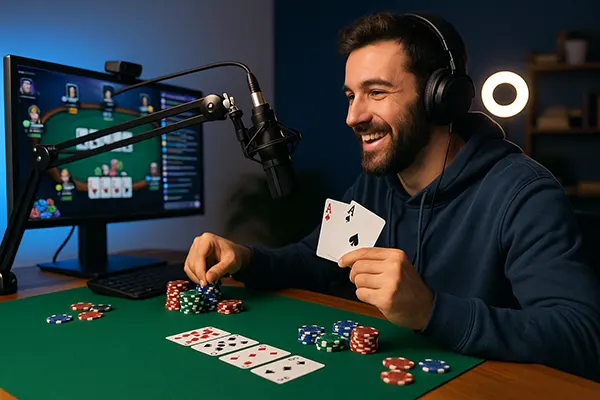
Poker in Streaming: How Twitch and Kick Are Transforming the Industry in 2025
The poker industry is undergoing a significant transformation in 2025, driven by the explosive popularity of streaming platforms like Twitch and Kick. What was once a game confined to smoky casino rooms is now a thriving online spectacle. These live broadcasts allow millions of viewers to engage with the game, learn strategies, and follow charismatic personalities who are reshaping the way poker is consumed and understood.
The Rise of Poker on Twitch and Kick
Over the past few years, Twitch has established itself as a hub for poker fans, attracting top players, commentators, and poker rooms eager to reach a younger and tech-savvy audience. Now, in 2025, Kick is also making significant strides, challenging Twitch’s dominance with more flexible monetisation policies and better revenue splits for streamers.
This competition has led to a surge in poker content, with live cash games, tournament streams, and instructional sessions streamed daily. The immediacy and interactivity of the format help players build loyal communities while demystifying poker for a new generation.
Notably, both Twitch and Kick now feature official collaborations with major poker brands. These partnerships ensure high production values and exclusive events that further elevate the profile of online poker in the streaming ecosystem.
Streamer Influence and Community Building
Modern poker streamers are not just players — they are content creators, entertainers, and educators. Their impact goes beyond gameplay as they cultivate communities based on shared interests and transparent communication. Many streamers integrate chat Q&As, viewer hand reviews, and giveaways to create a participatory experience.
Popular names like Lex Veldhuis, Fintan Hand, and newer stars from Kick are not only broadcasting games but also offering real-time insights into decision-making processes. This educational angle has attracted both recreational players and aspiring professionals.
As these communities grow, they contribute to poker’s evolution from a solitary game into a social activity, bridging geographical and demographic gaps like never before.
Monetisation and Sponsorship in 2025
Monetisation models for poker streamers have matured significantly. On both Twitch and Kick, streamers now benefit from direct subscriptions, ad revenue, tips, and affiliate deals with poker rooms. In 2025, Kick’s creator-focused approach has sparked a wave of migration, particularly among mid-tier streamers seeking better earnings.
Sponsorship deals are also more sophisticated. Poker rooms no longer just brand the stream; they integrate their own ambassadors into live sessions, run co-branded tournaments, and produce behind-the-scenes content exclusive to streaming audiences.
This monetisation has turned poker streaming into a viable profession, encouraging a more consistent content schedule, higher-quality production, and a broader range of programming — including travel vlogs, hand analysis sessions, and collaborations with non-poker streamers.
Professionalisation of the Streaming Space
As poker streaming becomes more lucrative, professionalism has increased. Many streamers now employ editors, community managers, and social media strategists. Some even work with production studios to enhance visual and sound quality, ensuring their broadcasts meet modern entertainment standards.
The professionalisation also reflects in content planning. Streamers often follow seasonal schedules aligned with major poker events like the WSOP, EPT, and WCOOP, capitalising on traffic peaks and engaging in cross-promotion with event organisers.
Furthermore, established players entering the streaming space bring new audiences, blending traditional poker fame with influencer culture and strengthening the symbiosis between poker media and the global poker circuit.

Regulatory Challenges and Market Differences
Despite the growth, regional regulations remain a hurdle for poker streaming. Countries like Germany and the Netherlands have implemented restrictions on gambling content, impacting stream visibility and revenue. Meanwhile, the UK and parts of North America maintain relatively streamer-friendly environments.
To navigate this, many streamers adapt their content or employ geo-blocking. Some diversify into educational or entertainment content when facing limitations, while others shift their primary audience to more receptive markets.
Kick’s emergence has also sparked legal scrutiny due to its relatively lax moderation compared to Twitch. In 2025, regulatory bodies are closely watching how Kick handles gambling-related content, which could shape the platform’s long-term viability in the poker streaming space.
The Future Outlook for Streamed Poker
As we move through 2025, the poker streaming space is expected to keep evolving. Innovations such as real-time stats overlays, integrated coaching tools, and multilingual broadcasts are already in development. These features aim to make poker more accessible and appealing to broader audiences.
Meanwhile, collaborations between poker rooms, software developers, and streaming platforms suggest a more immersive future. Augmented reality and interactive viewing experiences could soon redefine how fans engage with poker content.
Ultimately, Twitch and Kick are not just transforming poker streaming — they are reshaping the cultural perception of poker itself. From a niche card game to a dynamic, global spectator sport, poker’s digital renaissance is well underway.



